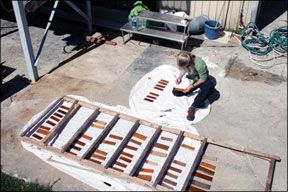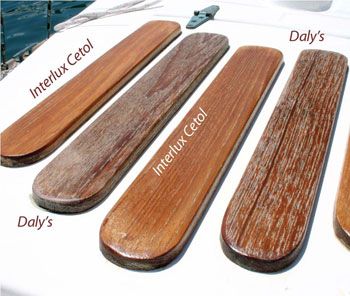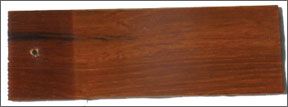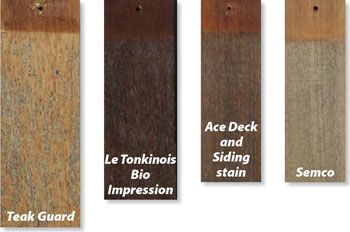Do you ever wonder why its called “wood finish?” Youre never “finished” with it. Unfortunately, that rings true for most boat maintenance tasks. With that harsh reality in mind, we set out in 2007 to find the best exterior wood finish on the market, one thats durable and easy to apply.
Since then, weve reported on and rated the application and original finish of more than 50 products in our long-term exposure test. In the August 2007 issue, we introduced the one-part test varnishes, followed by the initial report on synthetics and teak treatments (varnish alternatives) in the October 2007 issue, and two-part varnishes in the December 2007 issue. In April 2008, we wrapped up the application reporting with teak oils and stains.
After multiple delays, including two brushes with tropical storms, we mounted the test rack outdoors last summer to begin the exposure test. (See “How We Tested.”) This report takes a look at how the test panels are faring after six months facing the elements on The Rack (pictured above), the moniker weve given to our test set-up.

What We Tested
Practical Sailor
So in our quest for the Holy Grail of wood protectors, we refrained from limiting the test to a single type of coating and are looking for a wood finish all-star. However, to make the data easier to digest, weve broken the test field into four categories-one-part varnishes, two-part varnishes, synthetics and treatments, and sealers and oils. This apples-to-apples and apples-to-oranges comparison, we hope, will answer that often-asked reader query: “What wood finish should I use?”
The number of coatings on the market today is mind-boggling, hence the dozens of products in this evaluation. And, as with bottom paint, delving into formulation differences and the science behind the magic tends to only muddy the waters.
So when choosing a wood finish, knowing the basic characteristics of each finish type is helpful in determining which best matches your aesthetic tastes, maintenance appetite, and protection needs.
Varnishes
Another downside to these hard coatings is that they may crack or peel over time, requiring spot maintenance or stripping and re-applying. A glossy, mirror-like finish also tends to show nicks and scratches more readily than lower-gloss or soft finishes.
Two-part varnishes offer a more abrasion-resistant finish, but that super-hard shell means sanding for touchups is more of a headache. The hard barrier also means the coating will blister if moisture migrates up through fastener holes, so epoxying the holes and resetting fasteners before varnishing is a good idea.
In short: Application and prep tend to be arduous, as does re-applying, but these are more durable than soft coatings and offer that classic, mirror-like finish.
Synthetics and Stains:
Synthetics and stains penetrate deep into the wood, and are more flexible than varnish, so they allow the substrate to breathe and will not crack or peel. Many synthetic finishes have added pigments that can turn the wood red, yellow, or an opaque brown. Considered varnish alternatives, some combine an oil-based bottom coat and a glossy sealer coat to offer the deep penetration of an oil and a hard varnish-like shell.
Synthetics and stains come in a range of glosses, but rarely will have the high-gloss wet look of a varnish. Opaque stains have more solids, which mask the woods grain more than semitransparent products but claim to offer better protection from harmful UV rays, the nemesis of a clear varnish.

In short: Synthetics and stains are a breeze to apply, maintain, and re-apply, but may not last as long as a hard varnish finish.
Teak oils and sealers:
What sets a teak oil and a teak sealer apart is the amount of solids in the product. Sealers usually have a higher percentage of solids, providing better protection from UV light and allowing the coating to build up faster on the substrate. They also last longer than oils, typically.
How We Tested
The focus of this exterior wood finishes all-star test is to evaluate three things: a products ease of application; the integrity of its gloss and appearance; and how it fares over time under real-world conditions. These results will offer a larger picture of which type of wood finish has the most longevity and which products stand out among their peers.
Except for a number of latecomers, the products were applied to panels cut from the same bare teak stock. Testers did not note any irregularities in performance that might be attributed by differences in wood stock.
Each product was applied per manufacturers instructions, and testers rated each ones ease of application-how smoothly the product went on, how complete the instructions were, and how simple the process was. Each product and each panel were assigned a number so that judging could be done blindly.
For the varnishes, testers evaluated and rated the original gloss shine and reflective qualities. Because the other coatings often have matte or semi-gloss finishes, they received no “original gloss” rating.
Last summer, the panels were mounted on a rack that was set up at a 45-degree angle in an unobstructed area on the roof of the Practical Sailorworkshop in Sarasota, Fla. This ensured that all panels received the same amount of exposure to the weather and UV rays. A portion of each mounted panel was covered so testers would have a control to compare the weathered area and original finish over time. When rating the panels, testers removed the covers and rated each for coating integrity, color, and gloss retention.

Because our test setup lacks a way to simulate sea-spray-and baked-on salt water can shorten a coatings lifespan-weve put some top finishes into service aboard test boats. Testers will continue to regularly check the panels and test boat applications, and well report the results every six months or so.
How We Rated
After six months of weathering the South Florida elements, the panels were rated for coating integrity, color retention, and gloss retention.
Coating integrity ratings took into account the entire panel. Excellent ratings were given only to those with a totally uncompromised coating.
Color and gloss retention ratings are relative to the panels original finish, not the finish of other coatings. So although a panel may have had only a Fair rating for its initial gloss, if it maintained that same level of gloss for six months, it earned an Excellent for gloss retention.
Initial gloss and ease of application ratings are relative to the field within each coating category, and these were assigned immediately after the panels were coated.
Recommended varnishes for a single season earned three or more “Excellent” ratings in the following categories: ease of application, coating integrity, color retention, and gloss retention. Recommended varnish alternatives earned at least two Excellent ratings, and a Good or better for coating integrity.
Because no oil or sealer performed well enough after six months to earn an Excellent, we recommend the only one that rated above Poor on coating integrity-Star brite Tropical Teak Sealer-for a season of protection.

Panels with Poor coating integrity were pulled from the test. Most of these were teak oils, which testers did not expect to make it through a full season of exposure.
What We Found
So far, our findings support our past tests and real-world experience: If you want a multi-season coating, oil is not the finish to use. Teak oils need to be re-applied every few months. Like woods natural oils, they dry up and wear away when exposed to UV and saltwater. When we started this exposure test, we expected them to be the first to get voted off the test rack, and so it was.
Star brite, the maker of multiple teak oil products, claims users can expect an oil to last three to four months in conditions like those found in Florida or up to six months in northern locales. The Star brite teak sealer lasted longer than other oils and sealers, implying that its higher solids content does offer better UV protection.
The finish categories with the highest ratings after a single season were the varnishes. All but two one-part varnishes (Coelan and HMG Coma Berenice) and two two-parts (Bristol Finish and Honey Teak) rated Excellent for coating integrity, and all but one rated Good or better for color and gloss retention. Both the Bristol and Honey Teak had only a slight loss of coating, and so, combined with their other ratings, are still in the running for long-term protection.
Seven one-part and one two-part (Honey Teak) varnishes did not fade or change color. All synthetics, oils, and stains had some color change. In some instances, the color change was actually preferred by testers. The Amazon Teak Lustre panels, for instance, lost some of their opaqueness, and turned from an opaque brown to a lighter blond, while retaining much of their initial gloss.
A few facts worth noting: The West Marine WoodPro Plus Semi-gloss is actually a re-branded Epifanes Rapid Clear. And Interluxs Jet Speed, which was rated well at the six-month mark, is not manufacturer-recommended for exterior use, unless its overcoated with a UV-filtering finish like Interlux Schooner.

Overall, the Interlux Sikkens Cetol products fared quite well after six months. The panel with Cetol Natural (without gloss), however, weathered slightly more than the other Cetol panels. On our test boats hatch trim (below), the Cetol Natural lasted about eight months in the South Florida sun before needing to be recoated. According to Interlux, their tests show that it performs as well as the more opaque Cetol Marine and Marine Light. The Cetol Natural, which has a more transparent finish than its sister products, contains a different blend of pigments than the others, and this could be why it didnt hold up quite as well in our test. Testers still prefer its more natural look to the opaque Marine and Marine Light.
The products that have been removed from the test rack are: Deks Olje No. 1, Interlux Premium Teak Oil, Star brite Premium Teak Oil, MDR Amazon Golden Teak Oil, Ace Wood Royal Deck and Siding Stain Oil, Semco, Crab Coat Gloss, Le Tonkinois Bio Impression, Dalys Teak Oil, and Nanovations Teak Guard.
Teak Guard and Crab Coat were the only non-teak oil products to be pulled from testing at six months. According to its maker, Crystalac Co., the Crab Coats early failure is unusual. Though weve ruled out application error as the cause, we plan to give the varnish alternative a second chance and will apply it to the teak trim on one of our test boats.
Teak Guard was re-formulated in 2008, after this test began. However, its maker claims our coating should have lasted six to 12 months and attributed the mildew on our test panel to the breakdown of the coatings waterproof top layer. The company says that re-applying the finish sooner would have prevented the mildew.
Conclusions
Selecting a wood finish (or nothing at all) comes down to what appeals to a boat owners sense of aesthetics, patience for prep and application, tolerance for regular maintenance, and proclivity for sanding and scraping. Other factors to be considered concern the area to be finished and its use, handling, and the traffic its likely to see. Obviously, we don’t recommend coating your teak decks with a slick varnish. But, if youre looking to spiff up cockpit trim or a toerail, and prefer an upfront investment of time and energy for the longevity payoff, choose one of the top one-part varnishes or synthetics with an overcoat. If youre on a budget and want high gloss, the Ace Spar Varnish and Minwax Indoor/Outdoor Helmsman Spar Urethane will suit your needs.
For those brightwork aficionados looking for a wet, high-gloss look, who enjoy the labor of love that is two-part varnish, any of the two-part products would work. Our top picks of this group so far are Nautiking Nautithane, Interlux Perfection, and Honey Teak. If youre looking for the most durable oil or sealer, Star brite teak sealer is a good choice.
For spots where a slippery-when-wet finish is not feasible, check out the top synthetics or teak sealer. We also recommend these for boat owners with little time or energy to spend on brightwork, those with an aversion to sanders and scrapers, and those less than deft with a brush.
For decks, our favorite is Semco. It doesn’t darken the wood, so decks stay cooler. Although it will need to be re-applied every few months, depending on conditions and usage, but reapplication is painless, and it fades away rather than leaving a partially failed coating that requires sanding. Most teak-oil makers, including Star brite, recommend scrubbing the deck with a teak cleaner before re-applying. With Semco, however, only regular washing is needed.
Any of the Recommended products on pages 24-25 are good choices for single-season exterior wood finishes. To see which ones can go the distance and last for multiple seasons, stay tuned for our one-year report.

Eight teak oils and sealers round out our test group. Often favored for their ease of application and resistance to blistering or cracking, oils and sealers are not as durable as other finishes. They require frequent re-application, every three to four months in most locations. They dry fast and penetrate deep into the wood, but they lack the hard protection of varnish. The thinner (less viscous) of these finishes make the most of teaks natural nonskid properties. Some teak oil critics maintain that this type of finish attracts dirt and encourages mold and mildew growth, which we found to be true in some of our test panels.This test field includes 17 products that fall into the synthetics and teak treatments category. The top selling point for these is their ease of application: They require fewer coats than varnish, dry faster, and require little or no sanding between coats. These softer finishes will need to be reapplied more frequently than varnish but less frequently than teak oils.: We tested 22 one-part varnishes and six two-part systems. One- and two-part varnishes are clear, hard coatings that allow the woods natural beauty to show through. They come in a variety of glosses, from the classic wet look to a matte finish, which is less slick and has less glare. Prep and application are more labor-intensive than with other finishes and require a more careful hand. But a high-quality varnish will typically last longer than other coatings types. They have the benefit of less frequent application and less frequent maintenance, but once the coating integrity is compromised, repairs may require stripping the wood totally. Two-part systems, which involve mixing a base and curing agent, require the most application effort, but are generally regarded as being more durable than single-parts. defines an ideal exterior wood finish as one that is relatively easy to apply, easy to maintain, lasts for multiple seasons, and wont break the bank. Thats a lot to ask, we know.
- Practical Sailor Value Guide: Varnish Alternatives, Teak Oils, and Teak Sealers
- Practical Sailor Value Guide: One-Part Varnishes and Two-Part Systems
- Wood Panels Outlined
- Contacts
- Practical Sailor Value Guide Exterior Wood Finishes (August 2007)
- Practical Sailor Value Guide: Exterior Wood Finishes (October 2007)
- Practical Sailor Value Guide: Exterior Wood Finishes (December 2007)
- Practical Sailor Value Guide: Exterior Wood Finishes (April 2008)
- Download PDF Format

































